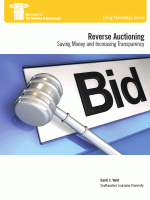
Reverse Auctioning: Saving Money and Increasing Transparency

Simply put, reverse auctions are auctions that enable sellers to “bid down” prices for their goods and services. The use of reverse auctions has substantially increased since Wyld’s initial report in 2000, albeit at a slower pace than anticipated in the earlier study. This new report contains original research on the potential of reverse auctions as a government cost-saving tool that also saves time and increases transparency. Specifically, Professor Wyld presents the following in this report:
- A case study of how the U.S. Department of State has used reverse auctions to save money and increase competition
- A numerical analysis of (a) the scope of government procurements appropriate for reverse auctions and (b) the estimated potential savings to be derived by government in increased use of reverse auctions
Wyld estimates that the federal government could save $8.9 billion by increasing the use of reverse auctions. Wyld’s research also estimates that the Department of Defense alone could save nearly $6.1 billion by increasing its use of reverse auctions. In addition to cost savings, the Wyld case study of the Department of State demonstrates that reverse auctions substantially increased competition among suppliers and saved departmental contract staff substantial time.
While there is clear evidence of the value of reverse auctions, their use in government has still been somewhat limited. For this to change, Wyld recommends that departmental chief acquisition officers be assigned responsibility for taking the lead and making procurement savings and efficiencies a strategy priority for their organizations, with reverse auctions a central focus of that effort. Wyld also recommends intensive staff training and change management initiatives as government implements new and innovative approaches to procurement.



